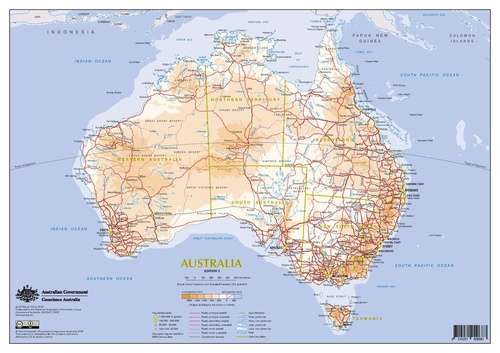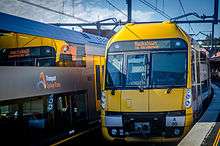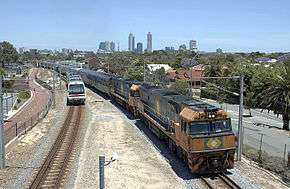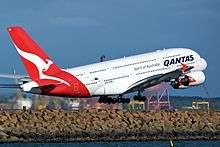Transport in Australia

There are many forms of transport in Australia. Australia is highly dependent on road transport. There are more than 300 airports with paved runways. Passenger rail transport includes widespread commuter networks in the major capital cities with more limited intercity and interstate networks. The Australian mining sector is reliant upon rail to transport its product to Australia's ports for export.
Roads

Road transport is an essential element of the Australian transport network, and an enabler of the Australian economy. There is a heavy reliance on road transport due to Australia's large area and low population density in considerable parts of the country.[1]
Another reason for the reliance upon roads is that the Australian rail network has not been sufficiently developed for a lot of the freight and passenger requirements in most areas of Australia. This has meant that goods that would otherwise be transported by rail are moved across Australia via road trains. Almost every household owns at least one car, and uses it most days.[2]
Australia has the second highest level of car ownership in the world. It has three to four times more road per capita than Europe and seven to nine times more than Asia. Australia also has the third highest per capita rate of fuel consumption in the world. Melbourne is the most car-dependent city in Australia, according to a data survey in the 2010s. Having over 110,000 more cars driving to and from the city each day than Sydney. Perth, Adelaide and Brisbane are rated as being close behind. All these capital cities are rated among the highest in this category in the world (car dependency).[3] The distance travelled by car (or similar vehicle) in Australia is among the highest in the world, being exceeded by USA and Canada.[1]
There are 3 different categories of Australian roads. They are federal highways, state highways and local roads. The road network comprises a total of 913,000 km broken down into:[4]
- paved: 353,331 km (including 3,132 km of expressways)
- unpaved: 559,669 km (1996 estimate)
Victoria has the largest network, with thousands of arterial (major, primary and secondary) roads to add.
The majority of road tunnels in Australia have been constructed since the 1990s to relieve traffic congestion in metropolitan areas, or to cross significant watercourses.
Public transport in Australia



Commuter rail
Sydney, Melbourne, Brisbane, Perth and Adelaide have extensive electric commuter rail networks which have grown and expanded over time. Australian commuter rail typically operates with bidirectional all day services with Sydney and Melbourne's systems operating with much higher frequencies, particularly in their underground cores. Sydney Trains operates the busiest system in the country with approximately 1 million trips per day. Melbourne Metro operates a larger system albeit with a lower number of trips.
Trams and light rail
Trams have historically operated in many Australian towns and cities, with the majority of these being shut down before the 1970s in the belief that more widespread car ownership would render them unnecessary. Melbourne is a major exception and today has the largest tram network of any city in the world. Adelaide has also retained one tram service - the Glenelg Tram that runs from Hindmarsh through the CBD to Glenelg Beach. Trams had operated in a number of major regional cities including Ballarat, Bendigo, Brisbane, Broken Hill, Fremantle, Geelong, Hobart, Kargoorlie, Launceston, Maitland, Newcastle, Perth, Rockhampton, Sorrento, Sydney and St Kilda.
Light Rail was constructed in Sydney in the 1990s with the conversion of a disused section of the Metropolitan Goods railway line into what is now the Dulwich Hill Line. A second CBD and South East Light Rail line in Sydney is currently under construction and is due to open in 2019. Light rail has also been built on the Gold Coast and other Light Rail systems will be opened in 2018-19 in Newcastle, Canberra and Brisbane.
Rapid transit
Major cities in Australia do not have full-fledged rapid transit systems, however a rapid transit line serving Sydney's north-west is currently under construction and in the planning for south-west rapid transit line. Melbourne, Sydney, Brisbane and Perth's commuter systems are all partially underground but do not reflect the typical rapid transit systems in international cities like New York City, Toronto, Osaka or Seoul.
Melbourne also has plans for a new train service branded as a metro, but will interconnect, with the suburban-style commuter system with the inner-city CBD segment acting as a rapid-transit style system.
The driverless Sydney Metro system is currently under construction, with the first line to be the Sydney Metro Northwest line. This new line will connect to the existing Epping to Chatswood railway line, which will be converted to rapid transit standards. It was also announced by Premier Mike Baird on 10 June 2014 that a stage 2 extension (now known as Sydney Metro City & Southwest) will continue from Chatswood, through a second harbour crossing, the city centre, and onto the current Bankstown Line.[5] When Sydney Metro is complete, it will be the first rapid transit system of any Australian city.
Intra-city public transport networks
The following table presents an overview of multi-modal intra-city public transport networks in Australia's larger cities. The only Australian capital cities without multi-modal networks are Canberra and Darwin, which rely entirely on buses. Canberra is planning a light rail line (Capital Metro), which will link with existing bus services, and is expected to be operational in 2018.[6]The table does not include tourist or heritage transport modes (such as the private monorail at Sea World or the tourist Victor Harbor Horse Drawn Tram).
| City | Overview | Integrated Network Name | Buses | Urban rail[7] | Light rail[8] | Monorail | Watercraft[9] | Rapid transit |
|---|---|---|---|---|---|---|---|---|
| Adelaide | Public transport in Adelaide | Adelaide Metro | Yes | Yes | Yes | |||
| Brisbane | Public transport in Brisbane | Translink | Yes | Yes | PlannedP5 | Yes | ||
| Canberra | Public transport in Canberra | Yes | Under constructionP1 | |||||
| Darwin | Public transport in Darwin | Yes | Limited | |||||
| Gold Coast | Public transport on the Gold Coast | Translink | Yes | Yes | Yes | Yes | ||
| Hobart | Transport in Hobart | Metro | Yes | Yes | ||||
| Melbourne | Public transport in Melbourne | Public Transport Victoria | Yes | Yes | Yes | Limited | Under constructionP4 | |
| Newcastle | Transport in Newcastle | "Transport" | Yes | Limited | PlannedP2 | Limited | ||
| Perth | Public transport in Perth | Transperth | Yes | Yes | Yes | |||
| Sydney | Public transport in Sydney | Transport for NSW | Yes | Yes | Yes | CeasedC1 | Yes | Under constructionP3 |
Notes
- P1 - Capital Metro - Planned for 2019
- P2 - Newcastle Light Rail - From 2017 under construction, open in 2019[10]
- P3 - Sydney Metro Northwest - Construction began in 2014 with an estimated completion date of 2019[11]
- P4 - Melbourne Metro Rail Project - Construction began in 2016 with an estimated completion date of 2026[12]
- P5 - Brisbane Metro Project - Announcement by the Lord Mayor for consultations on the project to begin in late 2016[13]
- C1 - Sydney Monorail - Ceased in 2013
Intercity rail transport

State Government owned rail services: Great Southern Rail lines:

The railway network is large, comprising a total of 33,819 km (2,540 km electrified) of track: 3,719 km broad gauge, 15,422 km standard gauge, 14,506 km narrow gauge and 172 km dual gauge. Rail transport started in the various colonies at different dates. Privately owned railways started the first lines, and struggled to succeed on a remote, huge, and sparsely populated continent, and government railways dominated. Although the various colonies had been advised by London to choose a common gauge, the colonies ended up with different gauges.
Inter-state rail services
The Great Southern Rail, operates three trains: the Indian Pacific (Sydney-Adelaide-Perth), The Ghan (Adelaide-Alice Springs-Darwin) and The Overland (Melbourne-Adelaide).[14] NSW owned NSW TrainLink services link Brisbane, Canberra and Melbourne to Sydney. Since the extension of the Ghan from Alice Springs to Darwin was completed in 2004, all mainland Australian capital cities are linked by standard gauge rail, for the first time.
Intra-state and city rail services
There are various state and city rail services operated by a combination of government and private entities, the most prominent of these include V/Line (regional trains and coaches in Victoria); Metro Trains Melbourne (suburban services in Melbourne); NSW TrainLink (regional trains and coaches in New South Wales); Sydney Trains (suburban services in Sydney); Queensland Rail (QR) operating long distance Traveltrain services and the City network in South-East Queensland, and Transwa operating train and bus services in Western Australia.
In Tasmania, 'TasRail' operates a short haul narrow gauge freight system, that carries inter-modal and bulk mining goods. TasRail is government owned (by the State of Tasmania) and is going through a significant below and above rail upgrades with new locomotives and wagons entering service. Significant bridge and sleeper renewal has also occurred. The Tasmanian Government also operates the 'West Coast Wilderness Railway' as a tourist venture over an isolated length of track on Tasmania's West Coast.
Mining railways
Six heavy-duty mining railways carry iron ore to ports in the northwest of Western Australia. These railways carry no other traffic, and are isolated by deserts from all other railways. The lines are standard gauge and are built to the heaviest US standards. Each line is operated by one of either BHP Billiton, Rio Tinto, Fortescue Metals Group and Hancock Prospecting.
A common carrier railway was proposed to serve the port of Oakajee just north of Geraldton, but this was later cancelled after a collapse in the iron ore price.
Cane railways
In Queensland about 15 sugar mills have narrow gauge (2 ft/610 mm gauge) cane tramways that deliver sugar cane to the mills.
Pipelines
There are several pipeline systems including:
- Crude oil: 2,500 km
- Petroleum products: 500 km
- Natural gas: 5,600 km
- Water
- Perth to Kalgoorlie - Goldfields Water Supply Scheme
- Morgan on the Murray River to Whyalla, Port Lincoln - Morgan-Whyalla pipeline
- Mannum on the Murray River to Adelaide - Mannum-Adelaide pipeline
- Waranga Western Channel, near Colbinabbin to Bendigo and Ballarat - Goldfields Superpipe
Projects under construction or planned:
Victoria
- Goulburn River to Sugarloaf Reservoir, Melbourne (North-South Pipeline, alternatively called the Sugarloaf Pipeline) - was connected to Melbourne in February 2010.[15]
- Wimmera-Mallee Pipeline - construction commenced in November 2006 and was completed in April 2010.[16]
- Melbourne to Geelong Pipeline - construction was completed in March 2012.[17]
- Rocklands Reservoir to Grampian Headworks Pipeline (Hamilton - Grampians Pipeline) - construction commenced December 2008, expected completion in 2010.
Waterways
Between 1850 and 1940 paddle steamers were used extensively on the Murray-Darling Basin to transport produce, especially wool and wheat, to river ports such as Echuca, Mannum and Goolwa. However, the water levels of the inland waterways are highly unreliable, making the rivers impassable for large parts of the year. A system of locks was created largely to overcome this variability but the steamers were unable to compete with rail, and later, road transport. Traffic on inland waterways is now largely restricted to private recreational craft.[18]
Ports and harbours


Mainland
General
- Adelaide, Brisbane, Cairns, Darwin, Fremantle, Geelong, Gladstone, Port Lincoln, Mackay, Melbourne, Newcastle, Portland, Sydney, Townsville, Wollongong
Iron ore
- Dampier
- Port Hedland
- Geraldton
- Oakajee - proposed 2006
- Esperance
- Port Lincoln - possible 2007
Tasmania
Merchant marine vessels

In 2006, the Australian fleet consisted of 53 ships of 1,000 gross register tons or over. The use of foreign registered ships to carry Australian cargoes between Australian ports is permitted under a permit scheme, with either Single Voyage Permit (SVP) or a Continuous Voyage Permit (CVP) being issued to ships.[19] Between 1996 and 2002 the number of permits issued has increased by about 350 per cent.[20]
Over recent years the number of Australian registered and flagged ships has greatly declined, from 75 ships in 1996 to less than 40 in 2007, by 2009 the number is now approaching 30. Marine unions blame the decline on the shipping policy of the Howard Government which permitted foreign ships to carry coastal traffic.[21]
There have also been cases where locally operated ships have Australian flag from the vessel, registering it overseas under a flag of convenience, then hiring foreign crews who earn up to about half the monthly rate of Australian sailors.[20] Such moves were supported by the Howard Government but opposed by maritime unions and the Australian Council of Trade Unions.[22] The registration of the ships overseas also meant the earnings of the ships are not subject to Australian corporate taxation laws.[21]
Aviation


Major Australian airlines operating domestic routes are:
- Qantas
- Jetstar (subsidiary)
- Virgin Australia
- Tiger Airways Australia (subsidiary)
There are many airports around Australia paved or unpaved. A 2004 estimate put the number of airports at 448. The busiest airports in Australia are:
- Sydney Airport Sydney, New South Wales SYD
- Melbourne Airport Melbourne, Victoria MEL
- Brisbane Airport Brisbane, Queensland BNE
- Perth Airport Perth, Western Australia PER
- Adelaide Airport Adelaide, South Australia ADL
- Gold Coast Airport Gold Coast, Queensland OOL
- Cairns Airport Cairns, Queensland CNS
- Canberra Airport Canberra, Australian Capital Territory CBR
- Hobart International Airport Hobart, Tasmania HBA
- Darwin International Airport, Northern Territory DRW
- Townsville Airport Townsville, Queensland TSV
Airports with paved runways
There are 305 airports with paved runways:
- Over 3,047 m (10,000 ft): 10
- 2,438 to 3,047 m (8,000 to 10,000 ft): 12
- 1,524 to 2,437 m (5,000 to 8,000 ft): 131
- 914 to 1,523 m (3,000 to 5,001 ft): 139
- Under 914 m (3,000 ft): 13 (2004 estimate)
Airports with unpaved runways
There are 143 airports with unpaved runways:
- 1,524 to 2,437 m (5,000 to 8,000 ft): 17
- 914 to 1,523 m (3,000 to 5,000 ft): 112
- Under 914 m (3,000 ft): 14 (2004 estimate)
Note:
sourced from CIA World Fact Book https://www.cia.gov/library/publications/the-world-factbook/index.html
Environmental impact
The environmental impact of transport in Australia is considerable. In 2009, transport emissions made up 15.3% of Australia's total greenhouse gas emissions. Between 1990 and 2009, transport emissions grew by 34.6%, the second-highest growth rate in emissions after stationary energy.[23]
Australia subsidizes fossil fuel energy, keeping prices artificially low and raising greenhouse gas emissions due to the increased use of fossil fuels as a result of the subsidies. The Australian Energy Regulator and state agencies such as the New South Wales' Independent Pricing and Regulatory Tribunal set and regulate electricity prices, thereby lowering production and consumer cost.
See also
References
- 1 2 "Transport in Australia". International Transport Statistics Database. iRAP. Retrieved 17 February 2009.
- ↑ "Where are we now?". Australian Automobile Association. Retrieved 3 February 2007.
- ↑ Urban Australia: Where most of us live. CSIRO. Retrieved on 15 July 2012.
- ↑ CIA world fact book.
- ↑ Gerathy, Sarah; Foschia, Liz (11 June 2014). "Sydney rapid transit rail build could begin in three years, NSW Transport Minister Gladys Berejiklian says". Retrieved 11 June 2014.
- ↑ "Capital Metro Light Rail Project to be delivered through Canberra's first large-scale private partnership". Katy Gallagher, ACT Chief Minister. 21 September 2012. Retrieved 4 May 2013.
- ↑ Includes electrified networks only
- ↑ includes modern tram networks
- ↑ includes public ferry and Water taxi services
- ↑ http://www.cs-dopravak.cz/zpravy/2016/7/4/dal-spch-panlsk-firmy-caf-tramvaje-dod-do-newcastlu?rq=newcastle
- ↑ Major milestones reached on North West Rail Link as preferred operator selected, Transport for New South Wales, Retrieved 24 June 2014
- ↑ , Melbourne Metro Rail Authority, Retrieved 3 October 2016
- ↑ ], Brisbane City Council, Retrieved 3 October 2016
- ↑ http://www.gsr.com.au/trains.htm
- ↑ "Sugarloaf Pipeline Project". Melbourne Water. Retrieved 15 July 2012.
- ↑ "Wimmera Mallee Pipeline". GWMWater. Retrieved 15 July 2012.
- ↑ "Melbourne to Geelong Pipeline". Barwon Water. Retrieved 15 July 2012.
- ↑ Ian Mudie Riverboats Sun Books, Melbourne, Victoria 1965
- ↑ Australian Shipowners Association. "Industry Policy". www.asa.com.au. Retrieved 2009-11-08.
- 1 2 Paul Robinson (26 March 2002). "Maritime unions slam use of 'cheap' foreign labour". The Age. www.theage.com.au. Retrieved 2009-11-08.
- 1 2 Martin Byrne (22 October 2009). "A new tanker ship for Australia" (PDF). Letter from the Australian Institute of Marine and Power Engineers to the Federal Minister. www.aimpe.asn.au. Retrieved 2009-11-08.
- ↑ Liz Porter (14 July 2002). "Shipping out, and definitely not shaping up". The Age. www.theage.com.au. Retrieved 2009-11-08.
- ↑ Australian Government Department of Climate Change and Energy Efficiency (2010). Australian national greenhouse gas accounts (PDF) (Report).
Sources
 This article incorporates public domain material from the CIA World Factbook document "2000 edition".
This article incorporates public domain material from the CIA World Factbook document "2000 edition".
